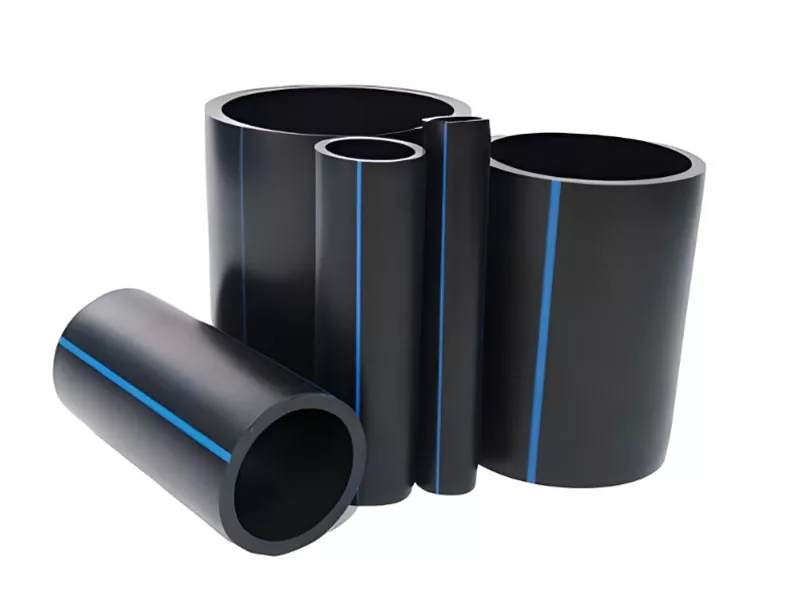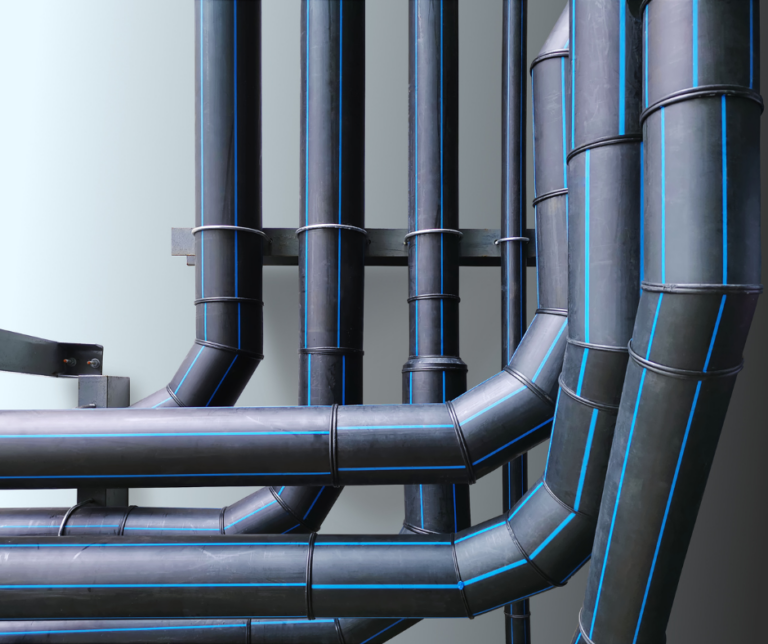hdpe pipe suppliers Midland TX: Checklist for Contractors
Wiki Article
Explore the Production Refine Behind High-Quality HDPE Pipe and Its Applications
The production procedure of top notch HDPE pipelines is complex and systematic. It starts with the choice of basic materials that boost efficiency. Following this, ethylene undertakes polymerization to develop material, which is then shaped through extrusion. Quality assurance is critical, ensuring that the end product fulfills strict standards. The journey of HDPE pipes does not finish with production. Their applications across various industries disclose a broader relevance worth checking out.Recognizing HDPE: Residences and Advantages

High-density polyethylene (HDPE) is a flexible thermoplastic known for its durability and resistance to numerous ecological factors. This material shows superb tensile toughness, making it appropriate for requiring applications. Its low-density structure adds to a light-weight product, helping with convenience of managing and installment. HDPE likewise showcases amazing resistance to chemicals, which decreases deterioration when revealed to rough materials.
The material's low dampness absorption even more boosts its durability, making it suitable for usage in pipelines and tank. Additionally, HDPE is immune to ultraviolet (UV) radiation, ensuring that products preserve their integrity even when subjected to sunshine. Furthermore, its flexibility permits for the production of elaborate shapes without endangering toughness. The eco-friendly nature of HDPE, frequently originated from recycled products, includes in its appeal, promoting lasting methods in manufacturing. In general, these properties and advantages make HDPE a preferred selection for various commercial and consumer applications.
Resources Choice for HDPE Manufacturing
The choice of raw products for HDPE manufacturing is important to validate the end product meets the wanted specifications and top quality standards. High-density polyethylene (HDPE) is mainly created from polymerized ethylene, stemmed from fossil fuels such as all-natural gas or unrefined oil. The top quality of these feedstocks considerably influences the mechanical and thermal homes of the final HDPE.Additives likewise play a considerable duty in enhancing HDPE's performance, including antioxidants, UV stabilizers, and colorants, which improve resilience and resistance to environmental factors. The option procedure need to take into consideration not just the chemical composition of the raw products yet likewise their processing attributes to ensure effective manufacturing.
Furthermore, the sourcing of resources must focus on sustainability and compliance with ecological guidelines, as responsible methods are important in today's market. Eventually, mindful resources option lays the foundation for generating high-quality HDPE pipelines suitable for varied applications.
The Extrusion Refine: Shaping HDPE Pipe
The extrusion procedure plays a crucial role fit HDPE pipes, beginning with thorough product preparation strategies that guarantee suitable flow and consistency. Equally crucial is the layout of the die, which directly influences the final dimensions and surface area quality of the pipeline. Together, these factors contribute considerably to the effectiveness and top quality of HDPE pipeline manufacturing.Product Preparation Techniques
Efficient manufacturing of HDPE pipes begins with meticulous material preparation methods, especially the extrusion process. During this phase, high-density polyethylene material is very first dried to get rid of wetness, making certain optimal circulation qualities. The resin is then fed into the extruder, where it goes through home heating and melting, changing right into a viscous state. This heating process is very carefully managed to preserve the material's stability and efficiency. The liquified HDPE is forced with a die, forming it right into a continual pipe kind. Proper temperature level management throughout extrusion is necessary, as it straight affects the material's buildings and the last item quality. Once shaped, the HDPE pipeline is cooled and reduced to defined sizes, ready for succeeding handling and applications.Die Design Value
Precision in die layout plays an essential role in the extrusion procedure of HDPE pipes. The die serves as the final shaping tool, straight influencing the pipeline's dimensions, wall surface thickness, and surface area finish. A well-designed die assurances consistent material flow, reducing problems such as abnormalities and weak areas. The geometry of the die should be enhanced to accommodate the specific buildings of HDPE, including its viscosity and thermal actions throughout extrusion. Additionally, the cooling rate of the material as it passes with the die can significantly impact the pipeline's structural stability. As a result, spending in advanced die innovation is vital for producers aiming to generate top notch HDPE pipelines that fulfill industry requirements and consumer expectations.Quality Control Procedures in HDPE Production
Various aspects influence the high quality of HDPE pipe manufacturing, effective quality control procedures are read more vital to ensure consistency and integrity in the last item (Pipe Manufacturing Midland TX). Trick quality assurance techniques consist of extensive material assessment, validating that the raw polyethylene satisfies well established requirements for pureness and thickness. During the extrusion process, criteria such as temperature, stress, and cooling time are very closely checked to preserve dimensional accuracy and structural stabilityIn addition, post-production testing is vital; suppliers commonly carry out hydrostatic examinations to examine the pipeline's strength and resistance to pressure. Aesthetic evaluations for surface area issues additionally enhance quality control. Accreditation from relevant criteria organizations, like ASTM or ISO, offers an extra layer of trustworthiness. By applying these detailed quality assurance measures, manufacturers can lessen issues, enhance performance, and ensure that the HDPE pipes fulfill the certain demands of numerous applications, ultimately causing consumer complete satisfaction and rely on the product.
Applications of HDPE Pipe Throughout Industries
HDPE pipes are used throughout numerous industries as a result of their toughness and versatility. In water distribution systems, they assure effective shipment, while in wastewater monitoring, they provide reputable solutions for waste transportation. In addition, farming watering networks benefit from HDPE's resistance to deterioration and flexibility, making it an optimal option for modern farming methods.
Water Circulation Systems
A considerable variety of industries depend on high-density polyethylene (HDPE) pipes for effective water circulation systems. Recognized for their resilience and resistance to deterioration, HDPE pipes are widely used in metropolitan water system networks, farming irrigation, and industrial applications. Their light-weight nature facilitates simple handling and installment, decreasing labor expenses and time. Additionally, HDPE pipelines can suit numerous stress levels, making them appropriate for both reduced and high-pressure systems. Texas hdpe pipe manufacturer. The adaptability of the material permits smooth combination right into existing infrastructure, lessening the need for considerable excavation. HDPE's resistance to chemical leaching warranties that the water delivered stays secure and clean, making it a perfect option for keeping the quality of drinkable water across numerous markets.Wastewater Management Solutions
Efficient water circulation systems also lead the way for innovative wastewater management options, where high-density polyethylene (HDPE) pipes play a substantial duty. Renowned for their longevity and resistance to deterioration, HDPE pipes are suitable for moving wastewater in different settings. Their adaptability allows for simple setup in complicated atmospheres, reducing the need for substantial excavation. Furthermore, HDPE's smooth indoor surface minimizes friction, improving flow rates and performance. These pipes are likewise resistant to chemical leaching, making certain that contaminants do not compromise the surrounding setting. Industries, communities, and therapy centers significantly count on HDPE pipelines for their reliability and longevity, making them a preferred selection for modern-day wastewater administration systems. This adaptability emphasizes the important significance of HDPE pipes throughout many applications.Agricultural Irrigation Networks
Agricultural irrigation networks profit considerably from the usage of high-density polyethylene (HDPE) pipelines, which supply efficient and reputable water distribution to plants. HDPE pipes are light-weight, making them simple to transfer and install, while their versatility enables different configurations in varied surfaces. These pipes show exceptional resistance to corrosion, chemicals, and UV radiation, making certain toughness in extreme agricultural settings. Additionally, their smooth indoor surface area decreases friction loss, maximizing water flow and lowering energy costs related to pumping. The longevity of HDPE pipes, frequently surpassing 50 years, contributes to decrease maintenance and replacement costs. Subsequently, farmers significantly rely upon HDPE pipes to enhance watering efficiency and promote lasting farming techniques, eventually resulting in enhanced crop returns and source conservation.Future Trends in HDPE Pipe Innovation
As the need for lasting and effective infrastructure grows, developments in HDPE pipeline technology are poised to change different industries. Emerging patterns consist of the assimilation of smart innovations, such as sensors and IoT capacities, which help with real-time tracking of pipe conditions, decreasing maintenance expenses and stopping leakages. Additionally, the advancement of sophisticated production strategies, such as 3D printing, is enabling the production of complicated, personalized pipeline designs that provide to details task needs.Additionally, the focus on recycling and circular economic climate methods is driving the advancement of HDPE pipelines made from recycled products, enhancing sustainability. Enhanced jointing approaches, such as electro-fusion and mechanical installations, are additionally enhancing setup effectiveness and integrity. The growing emphasis on environmental laws is pressing makers to adopt greener production procedures, making certain that HDPE pipes not just satisfy market requirements but additionally promote an even more sustainable future for infrastructure development.
Frequently Asked Inquiries
Exactly How Does HDPE Compare to Other Plastic Products?
HDPE outshines numerous various other plastic products relating to sturdiness, chemical resistance, and adaptability. Its low density and high tensile toughness make it optimal for different applications, typically surpassing choices in both efficiency and durability.What Are the Ecological Impacts of HDPE Production?
The environmental influences of HDPE production consist of greenhouse gas emissions, power consumption, and prospective pollution from producing procedures. In addition, improper disposal can result in dirt and water contamination, elevating issues about long-lasting eco-friendly effects.Can HDPE Pipeline Be Recycled?
Yes, HDPE pipelines can be reused. Several facilities accept used HDPE for handling, changing it right into new products. This recycling adds to sustainability initiatives, minimizing plastic waste while saving resources and energy in the production cycle.What Is the Life-span of HDPE Pipes?

Exactly How Do Temperature Variations Impact HDPE Pipeline Efficiency?
Temperature level variants considerably impact HDPE pipe performance, affecting flexibility and stamina. High temperatures can result in softening, while low temperatures may trigger brittleness, inevitably affecting the pipeline's durability and viability for numerous applications in diverse environments.Report this wiki page